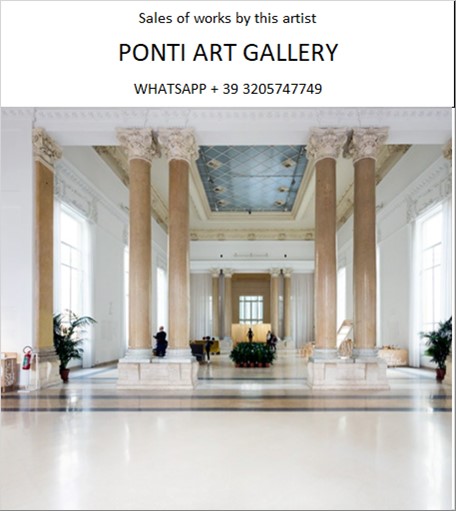Ponti Art Gallery is interested in buying and selling works
of art by this artist.

Rafael Coronel Biography
Rafael Coronel was a distinguished Mexican painter, renowned for his contributions to the Postwar & Contemporary art movement. Born into a family with a rich artistic heritage on July 24, 1931, in Zacatecas, Mexico, Coronel was destined to leave an indelible mark on the world of art. His grandfather was known for decorating the interiors of churches, his parents were musicians, and his older brother Pedro Coronel emerged as a prominent painter and sculptor.
Coronel's early life was steeped in creativity, which paved the way for his future endeavors in the arts. Despite initially aspiring to become a professional soccer player for Club América, his path took a decisive turn towards the arts when he moved to Mexico City in 1952 to study architecture at UNAM. It was during this period that he discovered his passion for painting, which led him to participate in an art contest and win a scholarship from the Instituto Nacional de la Juventud Mexicana. This scholarship allowed him to attend the Escuela Nacional de Pintura, Escultura y Grabado "La Esmeralda," where he studied under the tutelage of Carlos Orozco Romero.
Coronel's time at La Esmeralda was brief, but it was a pivotal moment that set the course for his artistic career. His rebellious spirit and refusal to conform to the school's norms led to his expulsion, but this did not deter him from pursuing his artistic vision. He soon caught the attention of Carlos Mérida, who introduced him to Galería de Arte Mexicano and its owner Inés Amor. By 1956, Coronel held his first solo exhibition at Amor's gallery, and within a year, he became its exclusive artist.
The late 1950s and 1960s marked a period of significant achievement for Coronel. He participated in high-profile exhibitions such as the Salón de la Plástica Mexicana in 1958 and had a solo exhibition at the Palacio de Bellas Artes in Mexico City in 1959. His work was recognized internationally, and in 1965, he was awarded the Cordoba Award at the Eight São Paulo Biennial.
Coronel's art is characterized by its unique expressionist figurative style, which delves into the psychological depths of human emotion and experience. His paintings often feature common men and women, capturing the existential angst of a society grappling with the challenges of industrial modernity. His work is a fusion of Mexican and European influences, with a particular affinity for the European Baroque artists of the 17th century. His technique and style reference the chiaroscuro tonality reminiscent of masters like Rembrandt and Goya.
Throughout his career, Coronel's art often depicted human figures, landscapes, and still life compositions, employing vibrant colors, meticulous details, and a touch of surrealism. His paintings showcased a deep understanding of Mexican culture and history, reflecting indigenous influences and the country's social issues. He was particularly interested in portraiture, inspired by everyday people he encountered on the streets of Mexico City.
Coronel's dedication to preserving Mexican cultural heritage was not limited to his paintings. He was also a collector of masks, puppets, and other artworks, much of which is displayed at the Rafael Coronel Museum in Zacatecas. The museum, housed in the former convent of San Francisco de Almoloyan y de Asís, showcases his vast mask collection, considered the largest in the world, along with a collection of works by Diego Rivera.
In recognition of his contributions to Mexican art, Coronel received many awards and accolades, including the National Prize for Arts and Sciences in 1992. His work has been exhibited in galleries and museums around the world, including the Museum of Modern Art in New York, the National Museum of Anthropology in Mexico City, and the Palacio de Bellas Artes.
Rafael Coronel's personal life was marked by tragedy and introspection. He became a widower in 1969 when his wife, Ruth, the daughter of Diego Rivera and Lupe Marín, passed away. Despite this loss, Coronel continued to travel and paint, finding solace and inspiration in his work.
Coronel's later years were spent in Cuernavaca, where he worked for two decades in his uncle's workshop, producing some of his most significant works. On the occasion of his 80th birthday, the Fine Arts Institute celebrated his career with a retrospective exhibition, showcasing his evolution as an artist and his continued exploration of the human condition.
Rafael Coronel passed away on May 7, 2019, in Zacatecas, leaving behind a legacy that continues to inspire artists and art enthusiasts alike. His contributions to the art world and his dedication to Mexican culture have cemented his place as one of the most important artists of his generation.
Rafael Coronel Quotes and
Sales of Works
Ponti Art Gallery selects and deals with paintings by the
artist. Upon request, we provide free estimates and
evaluations, communicate prices, quotations, and current
market values.
If you are interested in BUYING or SELLING works by the
artist, contact us immediately.
If you wish to sell or receive an evaluation of the
works:
Send us a frontal photo of the painting, one of the back,
and one of the signature. Also, indicate the dimensions of
the work. Inform us about the purchase origin of the work
and any kind of available documentation (purchase
receipts, certificates of authenticity, publications). One
of our operators will respond to you on the same day. We
guarantee maximum confidentiality and extreme
professionalism.
If you wish to purchase works by the painter: Contact us
and let us know your request. We will inform you about the
available works. We also offer the possibility to
subscribe to our NEWSLETTER, through which you will be
informed at the beginning of each month about the latest
acquisitions of the art gallery.
You can send us pictures of the work:
